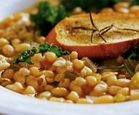|
Italian Soup Tuscan Bean Soup Italian comfort food. A creamy rich white bean soup flavored with ham and ladled over cheesey bread crisps.
Beans: Soak beans overnight. Or use quick soak method: bring beans to boil in 6 qt. water; boil 1 minute, turn off heat, and let beans sit 1 hour. Drain and use in the recipe. Soup: in a large pot, heat oil, add next 4 ingredients and saute till tender. Add garlic and saute for 2 more minutes. Stir in chicken broth, ham hocks, and soaked beans. Make a bouquet garni by using a cheesecloth square and tying together the bay leaves, parsley, thyme, rosemary, and pepper flakes; submerge in the broth. Simmer gently, over low heat, for 2 hours. Thickening: after 2 hours, remove ham hocks and set aside to cool. Discard bouquet garni. Puree half the mixture in a blender or food processor and return it to pot. When cool enough to handle, shred ham from hocks and add to the soup. Add salt & pepper to taste. Bread: while soup is simmering, lightly oil bread slices and toast in a 375 oven till golden brown. When soup is ready, place 2 pieces of toast in bottom of each individual soup bowl, cover toast with 2 T Parmesan cheese, ladle soup over bread slices, and serve. * Traditionally this soup calls for cannelli beans, but navy or great northern beans work well and can be easier to find. You can use canned cannelli beans, but they tend to be mushy. If you use them, drain and add to the soup during the last 30 minutes of cooking time. |
Tips & Glossary Arborio Rice: a medium-grained rice. Its high starch content yields a creamy texture and is the basis for risotto. Balsamic Vinegar: dark, thick vinegar with a sweet pungent flavor. Fermented, concentrated, and aged in wooden casks, sometimes up to 12 years. Can be pricey. Caper: salty, pickled bud of spiny shrub native to the Mediterranean region. Most prized is the non-pareil, the smallest (approx. 1/8”), though other sizes are tasty and less expensive. Formaggio: Cheese! Like France, Italy is a land of sublime cheeses, some 400 varieties. Here are some of the most widely sold in the U.S. Italian Seasoning: blend of dried herbs used in Italian cooking—marjoram, thyme, rosemary, savory, sage, oregano, and basil. Packaged commercially and found in most food stores. You can also make your own. Olive Oil: There's much more to know than is room for here. To learn all you need to know about the different grades of oil, and much, much more, head to Tanbourit. Pine Nuts: pinoli or pignoli; edible seeds of pine trees used in pesto sauce. Before cooking, release flavor by lightly browning in a heated skillet. Roasted peppers: buy or make your own: place under a broiler, or hold over a gas flame, till skin chars and blisters. Place in a closed paper bag for 15-20 minutes (to steam them). When cool, the skins slip off under water. Prosciutto: especially Prosciutto di Parma, dry-cured ham from Parma. The real deal! Cured up to 2 years, is almost sweet and very expensive. You can substitute with capicola, a delicious, light peppery ham.
|
Site by BOOM
![]()
LitLovers © 2024

